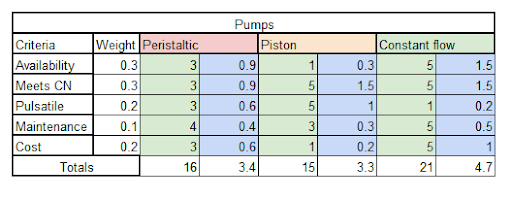Concept Generation for Pumps
Pumps will be key for completing our project to meet our clients needs. The pump will be used to create an anatomical pressure and flow rates of the fluid through the system. There are several pumps on the market that work with differing methods. The scope of this project is not to build a pump to achieve this flow so, the team will be looking to purchase a pump. This section will be covering the different type of pumps and not any specific brand in order to choose which style meets our criteria best.
Peristaltic Pumps
Peristaltic pump work by squeezing a flexible hose to push the fluid through the system. These pumps are usually built to deliver a set volume of fluid per beat. For the team budget it may not be feasible to purchase a peristaltic pump that would have an adjustable volume therefore, the pro and cons list will be based on a non adjustable volume pump. These pumps are used for this type of application because of their ability to self prime and to provide a precise amount of fluid per cycle [13].
Pros:
1. Cheap
2. Easily matinanced
3. Adjustable Cycles per minute
4. Precise volume output
5. Pulsatile flow
Cons:
1. Non-Adjustable volume
2. low pressure application
3. May be build to hold one size of hose
4. Cannot control wave platform
Piston Pumps
Piston style pumps are the best at replicating the hearts anatomical flow. These pumps are expensive and require regular maintenance. This maintenance requires the system to be drained of its fluid in order to remove the pump from the system. The main reason these pumps are more commonly used is that they are adjustable for volume, pressure, and cycles. These pumps are also of few that can create a sinusoidal flow in the system to match a hearts flow [12].
Pros:
1. Adjustability
2.Anatomical replication
3. Pulsatile flow
4. Sinusoidal pressure
Cons:
1. Expensive
2. Difficult Maintenance
Continious Flow
Continuous flow pumps are usually centrifugal or axial type pumps. These pumps are starting to be used in the field of artificial medical application. These pumps are adjusted by the speed of the of the flow and pressure by the diameter increase or decrease of the output hose. These pumps can be pulsatile with computer monitoring by regulating the motors speed in a sinusoidal waveform [33]. This is not impossible to achieve for the team but may take more time than is desirable when compared to purchasing a pump that already provided a pulsatile and sinusoidal flow.
Pros:
1. Inexpensive
2. Reddit available
3.Meets anatomical flow is computer aided
Cons:
1. difficult to set up pulsatile flow
(This work along with the referances can be found in Reports under "Preliminary Reports")
Concept Selection
The client requested that the system is to be able to replicate anatomical flow conditions. These flow conditions are met through pump choice and manipulation of a pump. The engineering requirements that were created for this customer need are mean flow rates of the iliacs and the aortic pressure. There is not a engineering requirement to describe the pulsatile flow because the heart does not meet any quantifiable function. The flow and pressure targets were previously mentioned in section 3.2.2.2, 5.1.1, and can also be found in the QDF in appendix A. There for the team has chosen to use a continuous flow pump in order to replicate a static state of the heart.
"Pugh Matrix"
